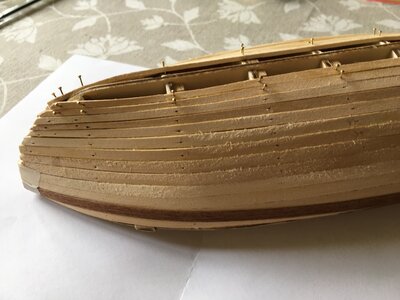When I've done hulls that don't have severe radius considerations (like the older ship-of-the-line like the HMS Victory and similar), I use the following process for the second planking layer. The half mm thick walnut planking provided for the second layer is very flexible, and I don't soak them because of potential shrinkage when they dry and I'm trying to avoid gaps between the planks. Is this gap issue a real concern? I honestly don't know; I've simply not chosen to test it.
Instead, I use painters tape to hold the strips down. I follow the kit instructions for where the first line should be placed, and then for the remainder, I let the strips lay naturally and trim the ends as required to fit properly against their neighbouring strips. Same as for the first layer, you then also need to cut the wedge strips (stealers) to fit gaps at the bow and stern.
Painters tape does a great job for most locations, and where I need to apply some additional pressure to get the curve to lay in against the hull, I simply use thicker pieces of leftover wood on top of the strip, and then the tape over the thick wood blockage pushes the thinner strip in to where it needs to be.
If you live in a very dry climate, or the kit has been sitting around for years, I add moisture to the wood strips in the following manner (it's not soaking, but rather a slow introduction of moisture in a somewhat enclosed environment): I used a plastic extendable tube that is normally used for transporting drawings or blueprints. The tube is watertight, and completely closed at one end. The other end is closed with a screw on plastic cap. I take a large zip lock bag and fill it with several paper towels and then pour in a cup of water. Leaving the bag open to allow the moisture to escape, I slide the bag down to the bottom of the tube. I then add my wooden strips into the tube, carefully inserting them so the ends don't go into the bag opening, but rather, to lay along the side of the bag and touching the bottom of the tube. I screw on the cap and leave it for several weeks. This is where I store the strips while working on the hull. If I do need to add additional water to assist with bending using a heated plank bending tool, I apply water to the plank directly with a sponge and let it sit for a couple of minutes to soak in. This is typically only something that I need to do with thicker (2mm) walnut strips that are used for the wales. Gradually bending the plank as you apply heat also cooks out the moisture so that when you're done with the bend, the plank is also mostly dried out as well.
Hope this helps...








